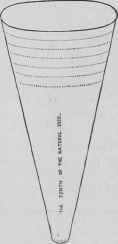Kitchen Utensils. Continued
Description
This section is from the book "The Epicurean", by Charles Ranhofer. Also available from Amazon: The Epicurean, a Complete Treatise of Analytical and Practical Studies on the Culinary Art.
Kitchen Utensils. Continued
Fontage Croustade Mold (Moule A Croustade Pontage)

Fig. 174.
Fig. 174 represents an iron in imitation of a small channeled timbale mold; it has a handle fourteen inches long, bent at the end and is furnished with a wooden handle. This mold is for the purpose of making fontage croustades (see Fontage, No. 907).
Kitchen Fork (Fourchette De Cuisine)
Fig. 175 represents a kitchen fork, used for turning over any broiled articles, sautes or else for tossing rice, etc.
Fig. 175.
Skewers And Hatelets (Brochettes Et Hatelets)
Kitchen skewers are of iron, used for supporting large pieces of meat when laid on the spit. Small game are run on to skewers; the blade is flat, rounded on one end and pointed on the other. Table skewers are of white metal, silver or plated ware; they are used when broiling kidneys or other meats which are thrust on them (Fig. 176). Fig. 176a represents a hatelet and should not be confounded with a skewer.
Fig. 176.

Fig. 176a.
Kitchen Grater (Rape De Cuisine)
An utensil made of tin having a semi-circular surface bored with projecting holes on which is to be grated either bread, cheese or various kinds of roots. There should always be two small graters in every spice box, one for grating nutmeg, the other for orange, lemon or Seville orange peel. The two latter ought to be enclosed in small separate boxes (Fig. 177).
Fig. 177.
Paste Pincher (Pince A Pate)
With this small pincher the crest of pies are pinched; it will be better to have two; one large and one small (Fig. 178).
Fig. 178.
Pastry Bag Or Pocket And Sockets (Poche Et Poche Avec Douilles)
These pockets are made of unbleached duck; they are used for laying out meringues, choux, or else quenelle forcemeat; they are of the greatest utility in kitchen and pastry work and it is advisable to have them of graduated sizes. The sockets are movable and are fitted in the bottom of the pocket before filling them.

Fig. 179.

Fig. 180.

Fig. 181.
Fig. 180 shows us the graduated different sizes reduced to the tenth of their proper dimensions; these are the ones most generally used for kitchen work and pastry.
Fig. 181 is half the natural size and represents a section of a series of sockets the most used for all work.
Souffle Pan, And Pie Dish (Casserole A Souffle, Et Plat A Tarte)
These vessels are of plated ware or sterling silver, made in different shapes and different sizes; they are indispensable in a kitchen and are used principally for cooking souffles, but they can also be used for baking purposes, for poaching creams by bain marie and in fact for serving vegetables or garnishings on the table (Fig. 182).

Fig. 182.
Pie Dish
Made of English china that can be placed in the oven without any danger of cracking; they are most useful. In these dishes one can cook meat, chicken, game or fish pies, fruit pies, or puddings, or creams, they can also be used for souffle's. There is no end to their utility in a kitchen and there should always be plenty of different sizes. What makes them more useful and convenient is that they can very well be placed on the table with their contents as they were taken from the oven; for instance, anything baked, creams, puddings, etc. (Fig. 183).

Fig. 183.
Kitchen Brushes (Pinceaux De Cuisine)
Brushes will be found very useful in a kitchen; it is better to have several; they can be made by any one; merely tying turkeys'tail feathers firmly together. Take the feathers, one by one, remove the feathers on each side, leaving only the end, then put about fifteen of these together, tie with rows of strings, beginning on the feathered end and girding tightly; fasten at the other or upper end, tying the string firmly; now cut the lower end to equalize the quills; they do not last very long. Brushes can be purchased made of hair with a tin handle, much neater, stronger and easier to keep clean; these are shown in the Figs. 184 and 184a.
Fig. 184.
Fig. 184a.
Continue to:


